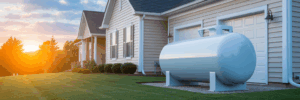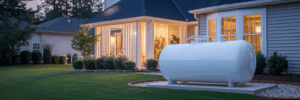
Why Winterizing Your Propane System Matters
As the first chill of autumn arrives, homeowners across the country begin thinking about one thing: staying warm. Securing a reliable heat source is a top priority, and for propane users, this means preparing your system before winter sets in. This isn’t just another chore on the list; it’s a fundamental step toward ensuring your family’s comfort and safety.
Cold weather directly affects propane. When temperatures drop below freezing, the pressure inside your tank can decrease significantly. This is because the liquid propane vaporizes more slowly in the cold. Lower pressure can impact the performance of your furnace, water heater, and other appliances, especially if your tank level is already low. You might notice weaker flames or appliances that struggle to ignite.
Think of it like a can of soda that’s gone flat in the cold; there just isn’t enough pressure to deliver what’s needed. Taking a few simple steps before the first frost can prevent the stress of an emergency call during a blizzard. Proactive maintenance is your best defense against system failures and ensures peace of mind all winter long.
Preparing Your Propane Tank for Cold Weather
Your first line of defense against winter issues starts with the tank itself. Proper placement is crucial. Your tank should always be located outdoors, at least ten feet from your house, with the surrounding area clear of any flammable materials like dry leaves or woodpiles. This simple step ensures proper ventilation and safety.
A key part of how to prepare propane tank for winter involves managing snow and ice. After a storm, it’s tempting to grab a shovel to clear a path, but that’s the last thing you should use on your tank. Use a soft broom to gently clear snow and ice from the tank, regulator, valves, and vents. Sharp objects like shovels or ice picks can damage the tank’s coating, leading to rust, or even harm critical components. Keeping these parts clear prevents moisture from freezing on them and ensures the system can breathe correctly.
Finally, think about your delivery driver. They need a clear, wide path to your tank for safe and timely refills, especially after heavy snowfall. A clear driveway and a shoveled walkway to the tank are not just a courtesy; they are essential for uninterrupted service. This simple act of propane tank winter care helps ensure you get the fuel you need, when you need it. A well-maintained system is the heart of a warm home, and for homeowners looking into their options, understanding our residential propane services is a great next step.
Maximizing Propane Efficiency During Winter
With your tank ready for the elements, the next step is to improve your system’s overall performance and reduce fuel consumption. The single best way to start is with a pre-winter professional inspection. Having a qualified technician check your entire system for leaks, rust, and proper function ensures it runs at peak efficiency, preventing wasted fuel and potential hazards.
You can also boost propane efficiency in cold weather with some simple home weatherization. We all know that drafty feeling near an old window. Sealing those gaps around windows and doors with caulk or weatherstripping makes a noticeable difference. Check your attic insulation levels as well, since heat naturally rises. A programmable thermostat is another powerful tool, automatically lowering the temperature at night or when you’re away, saving fuel without sacrificing comfort.
Don’t forget about your appliances. A furnace or water heater that is regularly serviced operates more efficiently, using less propane to produce the same amount of heat. Just like a car that gets better mileage after a tune-up, clean and well-maintained appliances are your ticket to lower energy bills. Smart consumption is just as important as tank maintenance.
Key Safety Measures for Winter Propane Use
Preparedness goes beyond efficiency; it’s about keeping your family safe. Understanding key winter propane safety tips is non-negotiable. The first thing every propane user must know is how to detect and respond to a leak. Propane has a distinct “rotten egg” smell added to it for this very reason. If you smell it, you must act immediately.
Follow this protocol without exception:
- Do not touch light switches, use a phone, or create any sparks.
- Immediately evacuate everyone from the building.
- From a safe distance away from the building, call your propane provider or 911.
Another silent threat is carbon monoxide (CO), an odorless, colorless gas produced by any fuel-burning appliance. Every home with propane should have CO detectors installed on each level, especially near sleeping areas. Test them monthly and replace the batteries annually. You should also know where your tank’s shut-off valve is and how to turn it off in an emergency. Finally, never use outdoor equipment like barbecue grills or portable heaters for indoor heating. They are not designed for indoor use and can create deadly levels of carbon monoxide. For a comprehensive overview of best practices, review these essential propane safety guidelines we’ve prepared.
| Potential Hazard | How to Detect It | Immediate Action Required |
|---|---|---|
| Propane Gas Leak | Distinct ‘rotten egg’ or sulfur-like smell | Evacuate immediately. Do not use electronics. Call for help from a safe distance. |
| Carbon Monoxide (CO) | CO detector alarm. Symptoms include headache, dizziness, nausea. | Evacuate to fresh air immediately. Call 911. |
| Appliance Malfunction | Soot, unusual noises, or a yellow/flickering burner flame | Turn off the appliance. Do not use it again until inspected by a professional. |
| Snow/Ice Blockage | Visible accumulation on tank, vents, or regulator | Gently clear with a soft broom. Do not use sharp objects. |
Smart Propane Refill Strategies Before Winter Hits
One of the most common winter worries is running out of fuel during a cold snap. The key question is when to refill propane tank. A good rule of thumb is the “30% rule.” Check your tank gauge regularly, and when it reads 30%, it’s time to call for a delivery. This provides a crucial buffer to prevent run-outs during periods of high demand or delivery delays caused by severe weather.
An even better strategy is to enroll in an automatic delivery program. Most suppliers offer this service, which eliminates the need for you to monitor the tank yourself. We track your usage and weather patterns to schedule refills proactively, giving you one less thing to worry about. It’s a convenient, set-it-and-forget-it option that ensures a continuous supply.
Finally, be proactive with your scheduling. We recommend topping off your tank in the late summer or early fall. This helps you avoid the winter rush, potential price increases, and ensures you are fully supplied before the first cold front arrives. If you need to schedule a delivery or find a supplier, you can easily search for propane near you on our site.
Your Winter Propane Preparedness Checklist
Getting ready for winter doesn’t have to be complicated. By focusing on a few key tasks, you can ensure your propane system is safe, efficient, and reliable. Here is a quick reference guide to help you stay on track:
- Schedule a professional system inspection before the cold weather hits.
- Fill your tank in the early fall to avoid the winter rush.
- Clear a wide, safe path to your tank and keep it free of snow and ice.
- Test all carbon monoxide detectors in your home and replace the batteries.
- Review your family’s gas leak response plan so everyone knows what to do.
These simple preparations are a small investment of time that pays significant dividends in safety and comfort. They transform winter from a season of worry into a season of warmth. For any questions or to schedule your pre-winter service, feel free to contact us directly. We’re here to be your trusted partner in winter preparedness.
About Jennifer Whitaker
Propane industry expert and content contributor for MyPropane.com.
View all posts by Jennifer Whitaker →Related Articles

Five Common Propane Tank Maintenance Mistakes to Avoid
Nov 21, 2025 • 7 min read
This article details five frequent errors in propane tank care and provides simple steps to prevent them.

Five Propane Tank Mistakes That Risk Your Home's Safety
Oct 29, 2025 • 8 min read
Discover simple, effective ways to maintain your propane system and prevent hazardous situations with our straightforward advice.

